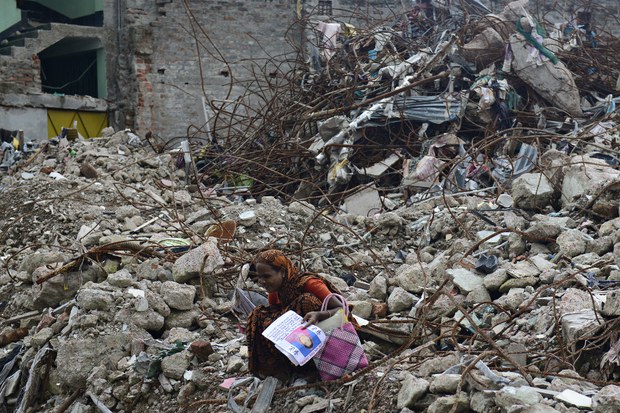Bangladesh to Launch Workplace Safety Day Around Rana Plaza Anniversary
2016.04.22
Dhaka
Three years after 1,136 workers died in the collapse of the Rana Plaza garment factory complex near Dhaka, Bangladesh is designating April 28 as a day for raising national awareness about occupational safety, a top official said Friday.
“Keeping the horrific Rana Plaza accident [in mind], we, for the first time, have decided to dedicate April 28 as the National Occupational Health and Safety Day,” Syed Ahmed, the inspector general of Bangladesh’s Department of Inspection for Factories and Establishments, told BenarNews.
“From now on, the government will observe the day every year to create consciousness among the factory owners, the workers and other stakeholders about occupation health and safety,” Ahmed said, adding that President Abdul Hamid would officially inaugurate the day at a ceremony in Dhaka on Thursday.
The third anniversary of the Rana Plaza disaster, one of the world’s deadliest industrial accidents and the worst ever in Bangladesh, falls on Sunday. Ahmed did not say why the government chose April 28 – not April 24 – for the specially designated day.
The nine-story Rana Plaza building, which housed five garment factories that churned out apparel for leading international labels, collapsed, killing 1,136 workers and injuring around 2,000 others, on April 24, 2013.
Bangladesh’s ready-made garments industry accounts for 81 percent of the country’s export earnings, according to a Reuters report.
Since the disaster, however, the government has faced widespread criticism from home and abroad for not doing enough to make garment factories safe and to bring to trial more than 40 people accused of murder and building-code safety violations in the Rana case.
The Rana Plaza structure was constructed in violation of the country’s building codes and housed more floors than permitted, a government investigation found.
“Is it a justice that the workers will have to work in a building where the roof will fall on them? Don’t we have the right to work at place where the building will not fall on us?” Mohammad Alam, a Rana Plaza survivor, told BenarNews.
Alam, who today pulls a rickshaw for a living, said he was now too scared to step inside a concrete building, fearing it may crumble on him.
“I will never serve a garment factory, even if I starve to death,” he said.
Awaiting a trial
Forty-one people, including the owner of the complex and a dozen officials in charge of building safety and inspection, were charged in June 2015 with murder in connection with the disaster, and could face the death penalty if convicted. Eighteen of the defendants also face charges for building-code violations.
Hearings into both cases, which will be tried separately, will take place on April 28, Additional Public Prosecutor Anwarul Kabir Babul told BenarNews.
Investigating officers were still cross-checking as many as 780 witnesses in preparation for the trial, Babul said.
“So, you can say that the trial is going to start three years after the tragedy. But is it so easy to interview each of the 780 witnesses?” he added.
The head of a labor group representing garment workers expressed frustration about the long wait for the trial.
“Three years have passed after the tragedy. How long should we wait to see the trial of the killers of so many people?” Mosherfa Mishu, president of the Garment Workers Unity Forum, told BenarNews.
‘39 factories closed’
Amid a global outcry and pressure from international buyers and global labor rights’ groups, government agencies and factory owners agreed to improve labor and safety standards at garment plants nationwide.
Two international groups dedicated to ensuring workers’ safety in the ready-made garments’ industry, Alliance and Accord, have been working with the department headed by Syed Ahmed.
He said his agency had inspected 3,746 out of 4,808 registered garment factories for safety.
“We have already closed 39 factories for poor safety standards. Additional floors of 42 more factories have been demolished so that the workers are safe there,” Ahmed told Benar.
Large cracks
However, three years on, labor and rights advocacy groups still question whether Bangladesh’s government is adequately upholding labor rights and protecting people from working in unsafe buildings.
On Thursday, Human Rights Watch called on Bangladesh to urgently remove legal and practical obstacles to the unionization of its garment industry. Only about 10 percent of more than 4,500 Bangladeshi garment factories have registered trade unions, according to HRW.
Three years after Rana Plaza, the country’s garment workers “remain at risk of interference and threats by factories” and the labor code imposes a formidable barrier because it “requires an unreasonably high 30 percent of workers in a factory to form a union,” New York-based HRW said.
“Let’s remember that none of the factories operating in Rana Plaza had trade unions,” HRW Deputy Asia Director Phil Robertson said.
“If their workers had more of a voice, they might have been able to resist managers who ordered them to work in the doomed building a day after large cracks appeared in it.”








